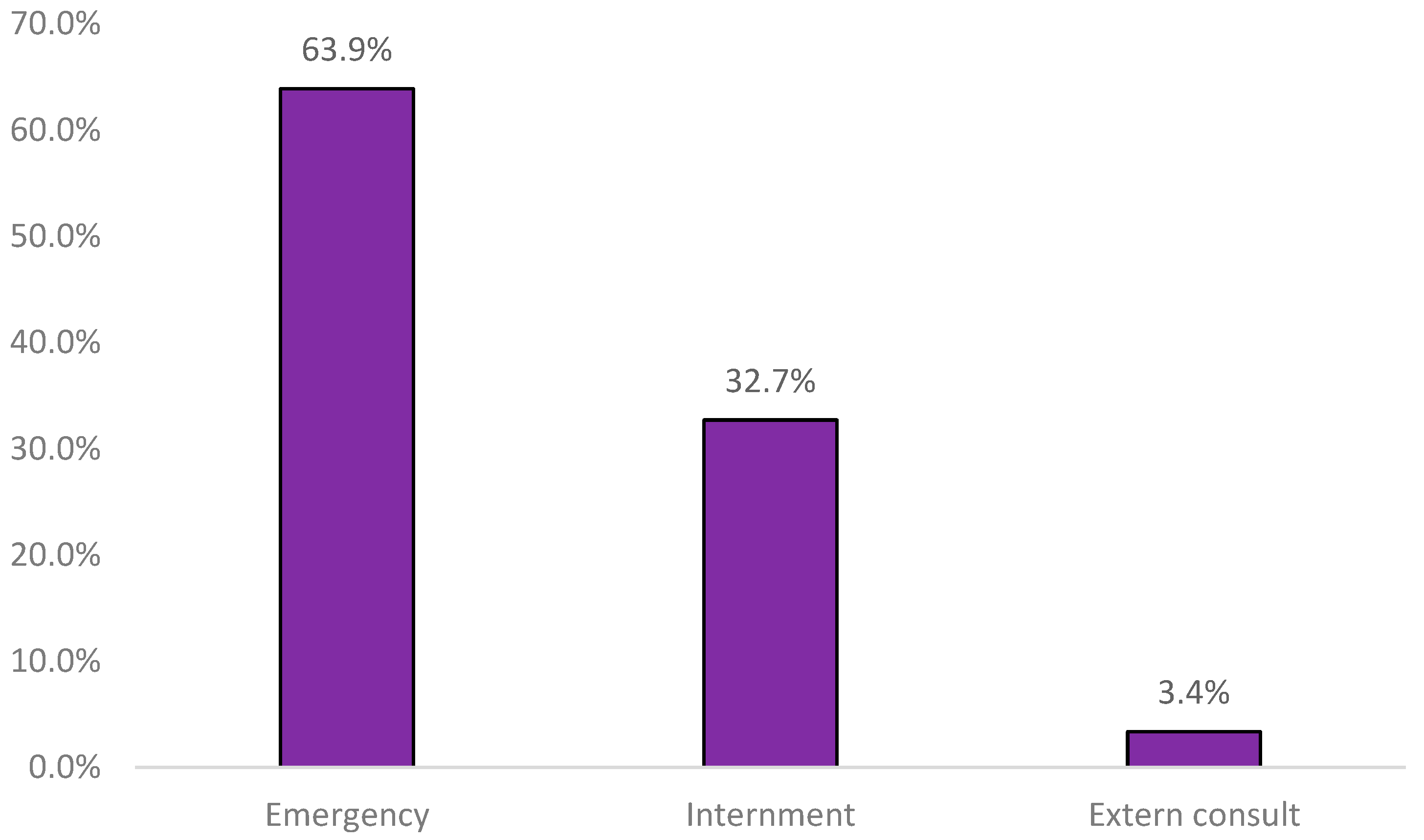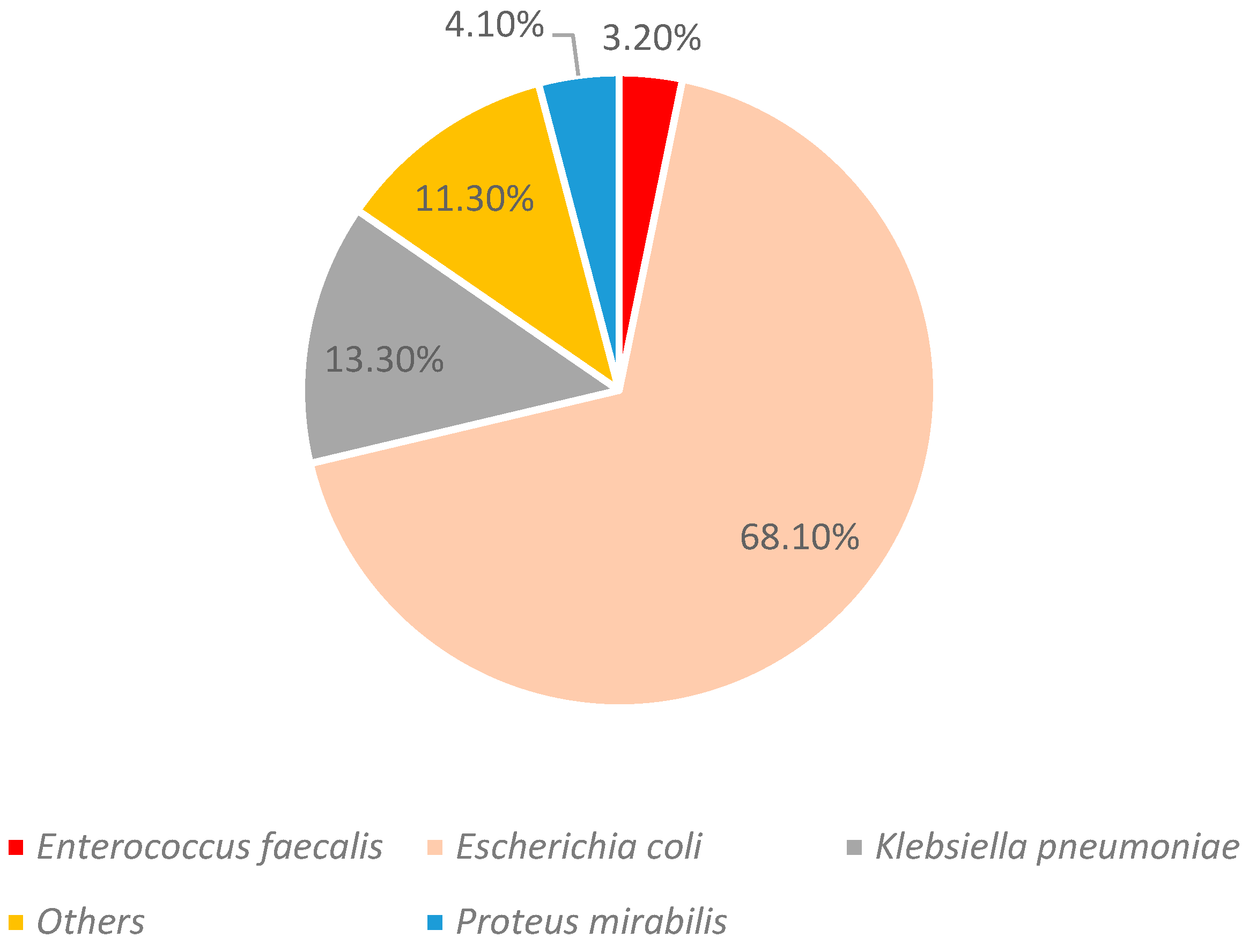Epidemiological Profile and Antibiotic Resistance in Urinary Tract Infections Among Elderly Women
Abstract
1. Introduction
2. Materials and Methods
2.1. Data Source and Variables
2.2. Microbiological Identification and Susceptibility Testing (Contextual Description)
2.3. Statistical Analysis
2.4. Ethical Considerations
3. Results
4. Discussion
5. Conclusions
Author Contributions
Funding
Institutional Review Board Statement
Informed Consent Statement
Data Availability Statement
Conflicts of Interest
References
- Matsumoto, T. Urinary tract infections in the elderly. Curr. Urol. Rep. 2001, 2, 330–333. [Google Scholar] [CrossRef] [PubMed]
- Sepúlveda, M.; Palomo, I.; Montecino-Garrido, H.; Wehinger, S.; Rodriguez-Mañas, L.; Trostchansky, A.; Fuentes, E. Physiological changes associated with aging: Identification of novel biomarkers for frailty syndrome in women. Free Radic. Biol. Med. 2024, 223, 160–171. [Google Scholar] [CrossRef] [PubMed]
- Query, H.; Carroll, A.; Klausner, A.P.; Burkett, L.S. A Review for Clinical Practice in the Treatment and Prevention of Recurrent Urinary Tract Infections in Women over Age 65. J. Women’s Health 2024, 33, 1735–1742. [Google Scholar] [CrossRef] [PubMed]
- Sako, A.; Yasunaga, H.; Matsui, H.; Fushimi, K.; Yanai, H.; Gu, Y.; Ohmagari, N. Hospitalization for urinary tract infections in Japan, 2010–2015: A retrospective study using a national inpatient database. BMC Infect Dis. 2021, 21, 1048. [Google Scholar] [CrossRef]
- Rodrigues, F.; Barroso, A. Etiologia e sensibilidade bacteriana em infecções do trato urinário. Rev. Port. Saúde Pública 2011, 29, 123–131. [Google Scholar] [CrossRef]
- Newlands, A.F.; Kramer, M.; Roberts, L.; Maxwell, K.; Price, J.L.; Finlay, K.A. Evaluating the quality of life impact of recurrent urinary tract infection: Validation and refinement of the Recurrent UTI Impact Questionnaire (RUTIIQ). Neurourol. Urodyn. 2024, 43, 902–914. [Google Scholar] [CrossRef]
- Rodriguez-Mañas, L. Urinary tract infections in the elderly: A review of disease characteristics and current treatment options. Drugs Context 2020, 9, 2020-4-13. [Google Scholar] [CrossRef]
- Harding, C.; Mossop, H.; Homer, T.; Chadwick, T.; King, W.; Carnell, S.; Lecouturier, J.; Abouhajar, A.; Vale, L.; Watson, G.; et al. Alternative to prophylactic antibiotics for the treatment of recurrent urinary tract infections in women: Multicentre, open label, randomised, non-inferiority trial. BMJ 2022, 376, e068229. [Google Scholar] [CrossRef]
- Luu, T.; Albarillo, F.S. Asymptomatic Bacteriuria: Prevalence, Diagnosis, Management, and Current Antimicrobial Stewardship Implementations. Am. J. Med. 2022, 135, e236–e244. [Google Scholar] [CrossRef]
- Rodrigues, F.; Coelho, P.; Mateus, S.; Caseiro, A.; Eideh, H.; Gonçalves, T.; Branco, M.C. Decoding Urinary Tract Infection Trends: A 5-Year Snapshot from Central Portugal. Clin. Pract. 2025, 15, 14. [Google Scholar] [CrossRef]
- Jover-Sáenz, A.; Ramírez-Hidalgo, M.; Bellés, A.B.; Murillo, E.R.; Bosch, M.B.; Cabanillas, J.C.; Garrido-Calvo, S.; Vilas, M.I.G.; Navés, L.G.; Caudevilla, M.J.J.; et al. Impact of a Primary Care Antimicrobial Stewardship Program on Bacterial Resistance Control and Ecological Imprint in Urinary Tract Infections. Antibiotics 2022, 11, 1776. [Google Scholar] [CrossRef] [PubMed]
- Droste, L.R.; Ratliff, C.R. Characteristics of Urinary Tract Infections and the Use of Cranberry Products in Patients With Urinary Diversions: A Narrative Review. J. Wound Ostomy Cont. Nurs. 2024, 51, 206–211. [Google Scholar] [CrossRef] [PubMed]
- Rosenthal, V.D.; Yin, R.; Nercelles, P.; Rivera-Molina, S.E.; Jyoti, S.; Dongol, R.; Aguilar-De-Moros, D.; Tumu, N.; Alarcon-Rua, J.; Stagnaro, J.P.; et al. International Nosocomial Infection Control Consortium (INICC) report of health care associated infections, data summary of 45 countries for 2015 to 2020, adult and pediatric units, device-associated module. Am. J. Infect. Control. 2024, 52, 1002–1011. [Google Scholar] [CrossRef]
- Shmoury, A.H.; Hanna, W.; Zakhour, J.; Zahreddine, N.K.; Kanj, S.S. Epidemiology and microbiology of catheter-associated urinary tract infections: A 14-year surveillance study at a tertiary care center in Lebanon. J. Infect. Public Health 2024, 17, 825–832. [Google Scholar] [CrossRef] [PubMed]
- Filev, R.; Lyubomirova, M.; Bogov, B.; Kolevski, A.; Pencheva, V.; Kalinov, K.; Rostaing, L. Urinary Tract Infections Caused by Klebsiella pneumoniae and Prolonged Treatment with Trimethoprim/Sulfamethoxazole. Microorganisms 2025, 13, 422. [Google Scholar] [CrossRef]
- Phiri, R.M.; Ertuğrul, M.B.; Bozdoğan, B.; Hoşbul, T. Evaluation of virulence genes in Proteus strains isolated from diabetic foot infections and urinary tract infections. J. Infect. Dev. Ctries. 2024, 18, 1559–1565. [Google Scholar] [CrossRef]
- Ruhal, R.; Sahu, A.; Koujalagi, T.; Das, A.; Prasanth, H.; Kataria, R. Biofilm-specific determinants of enterococci pathogen. Arch. Microbiol. 2024, 206, 397. [Google Scholar] [CrossRef]
- Torabian, P.; Singh, N.; Crawford, J.; Gonzalez, G.; Burgado, N.; Videva, M.; Miller, A.; Perdue, J.; Dinu, M.; Pietropaoli, A.; et al. Effect of clinically relevant antibiotics on bacterial extracellular vesicle release from Escherichia coli. Int. J. Antimicrob. Agents. 2025, 65, 107384. [Google Scholar] [CrossRef]
- Dulyayangkul, P.; Sealey, J.E.; Lee, W.W.Y.; Satapoomin, N.; Reding, C.; Heesom, K.J.; Williams, P.B.; Avison, M.B. Improving nitrofurantoin resistance prediction in Escherichia coli from whole-genome sequence by integrating NfsA/B enzyme assays. Antimicrob. Agents Chemother. 2024, 68, e0024224. [Google Scholar] [CrossRef]
- Venugopal, S.; Chunchanur, S.; Panigrahy, R.; Tak, V.; Yadav, M.; Chauhan, A.; Srinivasamurthy, H.; Rajendran, J.; Pundir, S.; Bhatt, S.; et al. Changes in antimicrobial resistance of Escherichia coli isolated from community-associated urinary tract infection before and during the COVID-19 pandemic in India. J. Glob. Antimicrob. Resist. 2024, 37, 165–167. [Google Scholar] [CrossRef]
- Maaland, M.G.; Jakobsen, L.; Guardabassi, L.; Frimodt-Møller, N. Pharmacokinetic and pharmacodynamic evaluation of nitrofurantoin against Escherichia coli in a murine urinary tract infection model. APMIS 2024, 132, 492–498. [Google Scholar] [CrossRef] [PubMed]
- Branco, M.C.; Coelho, P.; Rodrigues, F. Urinary Tract Infections in a Single Hospital in Central Portugal, a 5-Year Analysis. Microbiol. Res. 2024, 15, 850–863. [Google Scholar] [CrossRef]
- Grigoryan, L.; Trautner, B.W. Antibiotic Stewardship Interventions for Urinary Tract Infections in Outpatient Settings: A Narrative Review. Infect. Dis. Clin. N. Am. 2024, 38, 277–294. [Google Scholar] [CrossRef] [PubMed]
- Gohil, S.K.; Septimus, E.; Kleinman, K.; Varma, N.; Avery, T.R.; Heim, L.; Rahm, R.; Cooper, W.S.; Cooper, M.; McLean, L.E.; et al. Stewardship Prompts to Improve Antibiotic Selection for Urinary Tract Infection: The INSPIRE Randomized Clinical Trial. JAMA 2024, 331, 2018–2028. [Google Scholar] [CrossRef]
- Cabello, M.; Hernández-García, M.; Maruri-Aransolo, A.; Michelena, M.; Pérez-Viso, B.; Ponce-Alonso, M.; Cantón, R.; Ruiz-Garbajosa, P. Occurrence of multi-carbapenemase-producing Enterobacterales in a tertiary hospital in Madrid (Spain): A new epidemiologic scenario. J. Glob. Antimicrob. Resist. 2024, 38, 281–291. [Google Scholar] [CrossRef]
- Lee, Y.L.; Liu, C.E.; Wang, W.Y.; Tan, M.C.; Chen, P.J.; Shiau, Y.R.; Wang, H.Y.; Lai, J.F.; Huang, I.W.; Yang, Y.S.; et al. Antimicrobial resistance among imipenem-non-susceptible Escherichia coli and Klebsiella pneumoniae isolates, with an emphasis on novel β-lactam/β-lactamase inhibitor combinations and tetracycline derivatives: The Taiwan surveillance of antimicrobial resistance program, 2020–2022. J. Microbiol. Immunol. Infect. 2025, 58, 219–225. [Google Scholar] [CrossRef]
- Akinpelu, S.; Ajayi, A.; Smith, S.I.; Adeleye, A.I. Genotypic and phenotypic characterization of determinants that mediate antimicrobial resistance in Escherichia coli strains of clinical origin in South-Western Nigeria. J. Infect. Prev. 2024, 25, 126–133. [Google Scholar] [CrossRef]
- Fletke, K.J.; Jeong, D.H.; Herrera, A.V. Urinary Catheter Management. Am. Fam. Physician 2024, 110, 251–258. [Google Scholar]
- Asmare, Z.; Erkihun, M.; Abebe, W.; Ashagre, A.; Misganaw, T.; Feleke, S.F. Catheter-associated urinary tract infections in Africa: Systematic review and meta-analysis. Infect. Dis. Health 2024, 29, 172–179. [Google Scholar] [CrossRef]



| Antibiotic | Behavior Between 2018 and 2022 |
|---|---|
| Amoxicillin/Clavulanic Acid | Resistance decreased |
| Ceftazidime | Resistance remained unchanged |
| Cefuroxime Axetil | Resistance decreased |
| Ertapenem | Resistance decreased |
| Nitrofurantoin | Resistance increased |
| Piperacillin/Tazobactam | Resistance remained unchanged |
| Trimethoprim/Sulfamethoxazole | Resistance decreased |
Disclaimer/Publisher’s Note: The statements, opinions and data contained in all publications are solely those of the individual author(s) and contributor(s) and not of MDPI and/or the editor(s). MDPI and/or the editor(s) disclaim responsibility for any injury to people or property resulting from any ideas, methods, instructions or products referred to in the content. |
© 2025 by the authors. Licensee MDPI, Basel, Switzerland. This article is an open access article distributed under the terms and conditions of the Creative Commons Attribution (CC BY) license (https://creativecommons.org/licenses/by/4.0/).
Share and Cite
Rodrigues, F.J.B.; Coelho, P.; Mateus, S.; Metello, J.; Castelo-Branco, M. Epidemiological Profile and Antibiotic Resistance in Urinary Tract Infections Among Elderly Women. Women 2025, 5, 16. https://doi.org/10.3390/women5020016
Rodrigues FJB, Coelho P, Mateus S, Metello J, Castelo-Branco M. Epidemiological Profile and Antibiotic Resistance in Urinary Tract Infections Among Elderly Women. Women. 2025; 5(2):16. https://doi.org/10.3390/women5020016
Chicago/Turabian StyleRodrigues, Francisco José Barbas, Patrícia Coelho, Sónia Mateus, João Metello, and Miguel Castelo-Branco. 2025. "Epidemiological Profile and Antibiotic Resistance in Urinary Tract Infections Among Elderly Women" Women 5, no. 2: 16. https://doi.org/10.3390/women5020016
APA StyleRodrigues, F. J. B., Coelho, P., Mateus, S., Metello, J., & Castelo-Branco, M. (2025). Epidemiological Profile and Antibiotic Resistance in Urinary Tract Infections Among Elderly Women. Women, 5(2), 16. https://doi.org/10.3390/women5020016








